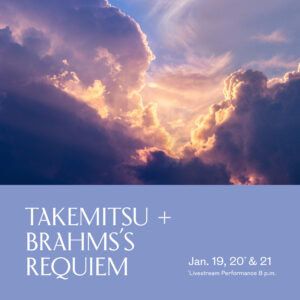
December 21, 2023
Tōru Takemitsu: Concert Hall and Cinema
Tōru Takemitsu, a self-taught composer, stands as a remarkable figure in the musical landscape, seamlessly weaving together diverse influences to create a sound uniquely his own. While his early lessons with Japanese composer Yasuji Kiyose focused more on art and aesthetics than composition, Takemitsu’s post-World War II exploration of Japanese music and involvement in the “New Composition Group” marked the beginning of a journey that would see him leave an enduring legacy in the concert halls and silver screen.
Takemitsu’s impact on film music is particularly noteworthy, boasting a prolific portfolio of over 100 soundtracks. His collaboration with directors of the Japanese New Wave, including his role as an assistant to composer Fumio Hayasaka, laid the foundation for his cinematic prowess. Although only having a 15-year-long career, Hayasaka composed the scores for some of the biggest names in Japanese cinema and is regarded by many as the finest Japanese film composer alive at the time. Hayasaka’s early musical style was influenced by the late Romantic composers of Western music but shifted towards
atonality and modernism later in his career. His music was closely related to Western music to keep with tradition and the demands of film makers, a style he undoubtedly passed on to Takemitsu. The upcoming performances of his composition Requiem for Strings by the Houston Symphony under Music Director Juraj Valčuha on January 18, 19 & 20 add a significant note to his cinematic journey, as this piece was dedicated to Hayasaka and garnered recognition from the legendary Igor Stravinsky in its early days. Requiem for Strings showcases Takemitsu’s ability to traverse the realms of both concert hall and cinema. The dedication to Hayasaka underscores the depth of his connection to the film world, while the recognition from Stravinsky attests to the universal appeal of his musical language.
Takemitsu’s compositional techniques reveal a skillful fusion of Western music, jazz, and traditional Japanese elements. His early exposure to jazz from his father, combined with his military service in the mountains west of Tokyo, shaped his unique synthesis of traditional Japanese instruments with Western music. Central to Takemitsu’s compositional philosophy is the Japanese concept of “Ma,” literally meaning negative space, where he artfully crafts spaces between sounds, allowing for a profound appreciation of both individual notes and the ensuing silence. This approach is evident not only in his concert hall compositions, but also in the atmospheric scores that have become synonymous with his cinematic contributions.
A dedicated film enthusiast attending an average of 300 movies annually, Takemitsu’s foray into the cinema expanded his musical reach. His collaboration with directors like Hiroshi Teshigahara and Kobo Abe during the Japanese New Wave produced avant-garde masterpieces that delved into themes of alienation in modern society. Films such as Woman in the Dunes and Kwaidan exemplify his minimalist style, a style for which he is equally renowned in the concert hall.
In Woman in the Dunes, Takemitsu employs modernist musical styles, utilizing advanced techniques on string instruments like glissandi and percussive sounds, along with electronic enhancements and distortion. The strategic placement of musicians at varying distances enhances dynamic shading, creating a truly immersive experience. Kwaidan, a three-hour long anthology of ghost stories, sees Takemitsu blending a Western orchestra with musique concrete, a type of music composition utilizing recorded sounds as raw material, and traditional Japanese instruments to evoke a palpable sense of terror. Takemitsu’s approach to film scoring, echoed in his concert hall compositions, emphasized the importance of silence in building tension. As he aptly puts it, “Even a single sound can be film music,” highlighting the nuanced interplay between sound and silence that defines his musical aesthetic.
In revisiting his Requiem for Strings, one can appreciate the seamless connection between Takemitsu’s cinematic and concert hall works. His ability to navigate the complexities of both realms reinforces his status as a visionary composer whose impact resonates far beyond the confines of any one musical genre.







